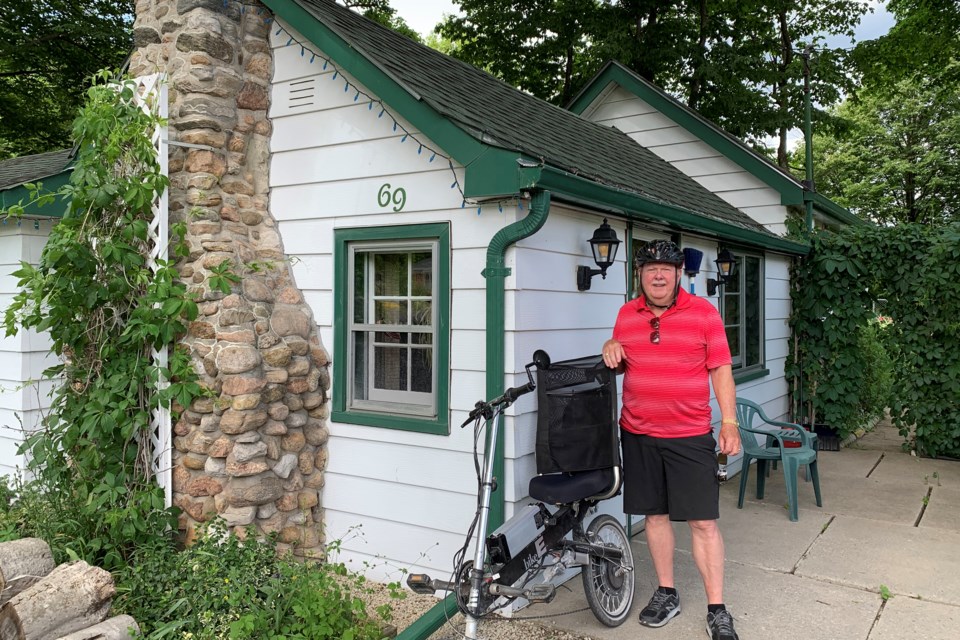A bit of mystery mixed in with history might not be a bad thing.
Go with what you know and let your imagination take it from there, including a human skull.
Wait, what?
Take, for instance, what seems to be a quaint cottage affair at the top of St. Vincent Street in Barrie's wonderful east end.
It might be easy to drive past — as you could be headed down the hill toward a sun-speckled Kempenfelt Bay, and a local school, students and cyclists would keep a good motorist rightfully distracted.
But there it is: a not-so-prominent cottage that has a fantastic past, and one that some Barrie families are proud to be a part of.
And historical baggage some local historians are still pondering.
Paul Marshall, 76 — sitting on a 21st-century cycle that somebody half his age might have a problem tangling with — grew up in the house at 69 St. Vincent and takes a bit of a breather in the June heat.
“It was my first home,” he says on the front porch of the cabin/house that used to be his family’s home, while taking a break from his cycling. “It’s unique in the aspect that my dad was like a homesteader in the 1930s.”
There are currently other owners at this time.
First World War veteran Joseph Keith Marshall — also a Second World War veteran — made the home a reality.
“He was 14 years old (in the First World War) when he enlisted and ended up in Toronto. If you had two legs and a heartbeat, they’d sign you up,” Paul says of his father. “He was wounded in a battle at Ypres, a town in the Belgian province of West Flanders.”
He was taken to a field hospital, and then another hospital, and eventually evacuated from Belgium to England, where a piece of shrapnel was taken out of his cheek.
“The doctor asked him, ‘How old are you my son?' And dad said, ‘I’ve been telling everyone for four years that I’m 18, and now I am 18’,” Paul says proudly.
Joseph, along with his wife Lillian, and his brother-in-law, later acquired Veterans’ Land Act grant properties near St. Vincent, Duckworth and Codrington streets.
They later merged and “dad owned the whole thing,” says Paul.
“Dad got the property in 1932 and by 1939, my brother Ron was born. The addition to the east end (of the cabin) was in place and the addition to the north was also there, but smaller than the current one,” he adds.
So began a family ‘cabin’ at the top of St. Vincent.
Before ‘Dad’ laid down his roots and work on future projects, however, the land around St. Vincent, Duckworth and Codrington streets had some other historical aspects: some known for sure and some, well, not so much.
“The first lot Dad sold was up on Codrington Street, at the pie-shaped piece of property (St. Vincent/Duckworth), and he owned a few lots on the north side of Codrington Street as well,” Paul says. “That first lot he sold was to a chap who came along and said, ‘I’m looking for a lot.' Dad made a deal on the back of a cigarette pack for 200 bucks.”
Paul, a retired Ontario Provincial Police officer, has some interesting memories of his families’ times on the east-end properties.
“There was a story about me watching the digger dig,” he says from his Shanty Bay home. “I would’ve been six or seven years old at the time. We lived in a house up the street at that time, (but) my parents had always owned the property and other lots south of where we lived at the time.
“So there was a new house being constructed and a steam shovel was putting in some service from the house to the road — water and sewer — and in one scoop up comes a male head with the hair still there. That’s something I saw,” Paul says.
“(The driver) of the digger — he always had a cigar in his mouth and he always had a Zippo lighter and he lit it: ‘puff, puff’ — said, ‘Well, I guess we better call the cops’. I have no memory about things after that, but I assume it was all backfilled in. I have no knowledge of who was buried there.
“That’s a story for chatting over tea.”
According to Deb Exel, of the Barrie Historical Archive, a 'Scotch burying ground' was established in 1850 in an area east of Duckworth and St. Vincent streets, just below Codrington. The burial ground was closed in 1907.
Local historian Andrew Hunter estimated there were about 96 graves on the site as of 1901, she says.
“The Marshall family home at 69 St. Vincent St. is still standing and Paul told me a gravestone was used for the hearth,” Exel says.
“I don’t know whether the Presbyterian church actually used the property as a burial ground or owned it,” Paul says, adding that a hearth for the fireplace of his family’s home is a gravestone.
“I know that for sure because of family history,” he says. “I never saw the engraving on the other side, but I do know some things about tombstones. I was in the business after retiring and it’s not a granite one; it’s either limestone or sandstone.
"It’s just plain. There are no identifying marks on it. It was a piece of flagstone,” says Paul, adding it was never meant to be disrespectful. “If somebody didn’t wan’t a tombstone (say) from over here and had it replaced and the other one was going for naught, you could just take it and use it as a step stone.”



